
The Inns on the National Road is a national historic district near Cumberland, Allegany County, Maryland. It originally consisted of 11 Maryland inns on the National Road and located in Allegany and Garrett counties. Those that remain stand as the physical remains of the almost-legendary hospitality offered on this well-traveled route to the west.
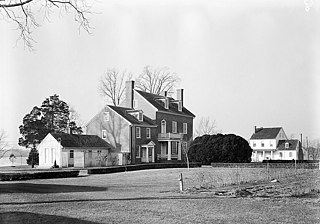
Potter Hall is a historic home located at Williston, Caroline County, Maryland, United States. It is an early-19th-century, Federal-influenced house facing the Choptank River. The house was constructed in three sections: a tall 2+1⁄2-story Flemish bond brick structure built about 1808 adjoining a lower 2+1⁄2-story, two-bay-wide central section built about 1750, also of Flemish bond brick, then a frame single-story kitchen wing added in 1930. Each of the three sections has a gable roof. Potter Hall was originally settled by Zabdiel Potter, who in the mid-18th century built a wharf and the small brick house. He developed Potter's Landing into a key early port for the shipping of tobacco to Baltimore.
The Wye Town Farm House is a historic home in Easton, Talbot County, Maryland, United States. It is of brick construction, one and one-half stories high and two rooms deep with a small one-story brick kitchen. A two-story addition was made in the 20th century. The original section of the house dates from about 1800.

Winsted, also known as the Todd House and the Old Brick House, is a historic home located at Aberdeen, Harford County, Maryland, United States. It is a two-story, five-bay brick federal style dwelling on a low stone foundation. Also on the property is a small one-story rubble stone smokehouse.

Broom's Bloom is a historic home located in Bel Air, Harford County, Maryland, United States. It is a two-story, frame and rubblestone, gable-roofed house, partially stuccoed and partially shingled. It took its present form from four distinct and discernible periods of growth, from about 1747 to about 1950. The oldest section is four bays by two, and has a hall and parlor plan, measuring approximately 36 by 20 feet. Also on the property is a one-story, rubblestone 18th century springhouse and a small family cemetery, which contains the earliest known grave stones in the county.
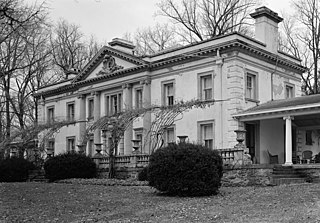
Liriodendron is a historic home and estate located at Bel Air, Harford County, Maryland, United States. It was the summer home of Laetitia and Dr Howard Kelly, a successful surgeon and founding member of the Johns Hopkins Medical College, and comprises the mansion named Liriodendron; the Graybeal-Kelly House; a c. 1835 bank barn; a c. 1898 carriage house; a c. 1850 board-and-batten cottage; and five other outbuildings including a corn crib, a smokehouse, two ice houses, and a shed. The 2+1⁄2-story, stuccoed brick mansion was designed by the Baltimore architectural firm of Wyatt and Nolting in the Georgian Revival style and constructed about 1898. The 2+1⁄2-story Georgian-style Graybeal-Kelly House, built about 1835, was the manor house for the farm until the mansion was constructed. It is used as a wedding, conference, and arts facility.
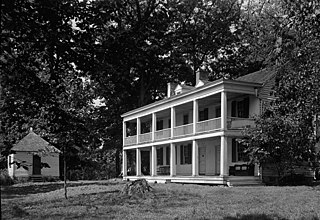
Mount Adams, also known as The Mount, is a historic home and farm complex located at Bel Air, Harford County, Maryland, United States. The complex consists of a 114-acre (46 ha) working farm, originally part of Broom's Bloom, centered on a large, multi-sectioned, 2+1⁄2-story frame house built in 1817 in the Federal style. The house has an 1850, 2+1⁄2-story cross-gabled addition, connected, but an independent unit from the main house, and slightly taller in the Greek Revival style. The property include a stone bank barn, a stone-and-stucco dairy, a stone-and-stucco privy, all dating from the early 19th century, as well as a family cemetery. Its builder was Captain John Adams Webster.
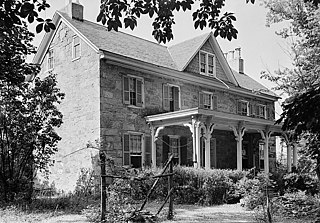
Proctor House, also known as the Cassandra Gilbert House, is an historic home located at Bel Air, Harford County, Maryland, United States. It is a two-story detached Carpenter Gothic style cottage with board and batten siding, constructed between 1860 and 1873 and enlarged about 1884. The interior features an arched slate mantel painted to resemble several colors of inlaid marble.
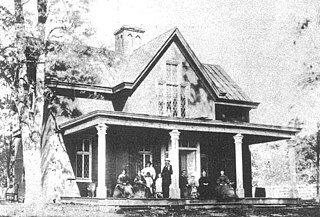
Tudor Hall is a historic home located at Bel Air, Harford County, Maryland, United States. It is a 1+1⁄2-story Gothic Revival cottage built of painted brick. The house was built as a country retreat by Junius Brutus Booth (1796–1852) from Plates 44 and 45, Design XVII, of The Architect, by William H. Ranlett, 1847. However, Booth never lived in Tudor Hall, because he died before it was completed. His son Edwin Booth lived there only briefly on his return from California before he moved the family back into Baltimore. But his other son, John Wilkes Booth, lived there with his mother, brother Joseph, and two sisters from December 1852 through most of 1856.

Rigbie House, also known as "Phillip's Purchase", is a historic home located at Berkley, Harford County, Maryland. It is a 1+1⁄2-story, frame and stone structure built about 1781. It was one of a series of forest outposts fortified against the Indians and representing Lord Baltimore’s claim of 1632 to land extending north to the 40th parallel. In April 1781, it was the place where the Marquis de Lafayette’s officers quelled a mutiny that might have prevented his army of New England troops, who had been headed homeward, from turning south again to join General Greene and General Washington at Yorktown, in which case that battle might never have been fought.

Fair Meadows is a historic home located at Creswell, Harford County, Maryland. It is a 2+1⁄2-story Second Empire–style house constructed in 1868 for the last owner of Harford Furnace, Clement Dietrich. The house is constructed of irregularly laid ashlar and features a mansard roof, cupola, dormers with rounded hoods, and stone quoins. The interior has a center hall plan and includes intricate inlay designs, black and white marble tiles in the center hall, plaster ceiling ornaments and friezes, marble mantels, and original crystal chandeliers. Also on the property are the ruins of a round springhouse, a one-story stone carriage house, a brick smokehouse, and three hip-roofed coursed rubble stone outbuildings. The estate was later home to Eastern Christian College.

Olney, originally patented as Prospect, is a historic home and farm complex located at Joppa, Harford County, Maryland. It is a 264-acre (1.07 km2) working pony farm with a collection of 15 structures ranging in style, use, and elegance. The main building on the property is a 2+1⁄2-story brick house dating to 1810, generally called "the mansion." The house was evolved into a museum of Maryland architecture, with salvaged features from demolished buildings in Baltimore and Philadelphia. These include paneling from the Isaac Van Bibber house in Fells Point, Baltimore dating to 1815; the marble Ionic portico from William Small's Baltimore Athenaeum from 1830; and a marble bas-relief plaque designed by Pierre L'Enfant for Robert Morris's great 1795 house in Philadelphia. Also on the property is an early-18th-century, 2+1⁄2-story stone dwelling and a variety of still-functioning farm structures that in themselves range in style from simple stone stables and frame hay barns to an unusual two-story brick blacksmith's shop. In addition, the 1914 Union Chapel School, was moved onto the property in 1980 and re-outfitted as St. Alban's Anglican Church. The property was developed by J. Alexis Shriver (1872–1951), a man prominent in local and state historical and agricultural matters who lived at Olney from 1890 until his death.

The Col. John Streett House is a historic home located at Street, Harford County, Maryland, United States. It is a Federal style home composed of three brick sections, two of which are original and one a late 19th-century addition. The original dwelling built about 1805, consists of a 2+1⁄2-story, five-bay, gable-roofed main section and a 2-story, two-bay attached kitchen. The kitchen wing section has two unequal-sized rooms on the ground floor and a large loft room above, reached by a closed, corner stair. The home is named for Colonel John Streett (1762-1837), a man prominent in local politics and a hero of the War of 1812 who led Harford's 7th Regiment Cavalry at the Battle of North Point.

Churchville Presbyterian Church is a historic Presbyterian church located at Churchville, Harford County, Maryland. It consists of three harmoniously designed sections: the original one-story, four by three bay, gable-roofed brick building dated to 1820; the three-story, restrained Italianate, brick bell tower added in 1870; and the low, one-story brick church hall and office added in 1950. Located adjacent is a sequestered 4.5-acre (1.8 ha) graveyard with stones dating back to 1819. The community of Churchville, which surrounds the church, grew up around and took its name from the structure.

Harford National Bank is a historic bank building located at Bel Air, Harford County, Maryland. It is a one-story, with day-light basement built in a modified Richardson Romanesque style of glazed red brick and rusticated brownstone. It was designed by architect George Archer in 1889.

Sophia's Dairy is a historic home in Aberdeen, Harford County, Maryland, United States. It is a large center-hall brick house, 64 by 45 feet, with a low stone wing, built in 1768 in the Georgian style. The interior features a double stair which extends upward on the west wall from both ends of the hall. It continues east in one short flight, then separates and parallels the lower flight to the second story hall.

The Little Falls Meetinghouse is a historic Friends meeting house located at Fallston, Harford County, Maryland, United States. It was constructed in 1843 and is a sprawling one-story fieldstone structure with shallow-pitched gable roof and a shed-roofed porch. The building replaced an earlier meetinghouse built in 1773. Also on the property is a cemetery and a one-story frame mid-19th century school building, with additions made post-1898 and in 1975. It features the characteristic two entrance doors and a sliding partition dividing the interior into the men's and women's sides. The Friends currently meet on the former men's side of the meetinghouse, and the women's side is only used for large groups and special occasions.

Bishopton is a historic home located at Church Hill, Queen Anne's County, Maryland. It is a 1+1⁄2-story, brick dwelling, three bays wide, and one room deep with a hall-parlor plan in the 18th century Tidewater Maryland/Virginia vernacular style It was built about 1711. The facades are laid in Flemish bond and the upper gables feature glazed chevron patterns.

Bel Air Courthouse Historic District is a national historic district at Bel Air, Harford County, Maryland, United States. It consists of a small cohesive group of buildings, mostly two or three stories of brick or frame construction that were erected or renovated in the 19th to early 20th century period and border the Harford County Courthouse which is a grand scale brick structure.

Medical Hall Historic District is a historic home and national historic district near Churchville, Harford County, Maryland, United States. The home was constructed of stuccoed stone between 1825 and 1840 and is five bays long, two bays wide, and two and a half stories high. The façade features a centrally placed door with sidelights and a rectangular transom subdivided in a radiating pattern. Also on the property is a stone springhouse which 20th century owners have converted into a pumphouse and a stone cottage believed to be a 19th-century tenant house. The property is associated with John Archer (1741–1810), the first man to receive a degree in medicine in America. One of his sons was Congressman, judge of the circuit court, and Chief Justice of Maryland Stevenson Archer (1786–1848).























